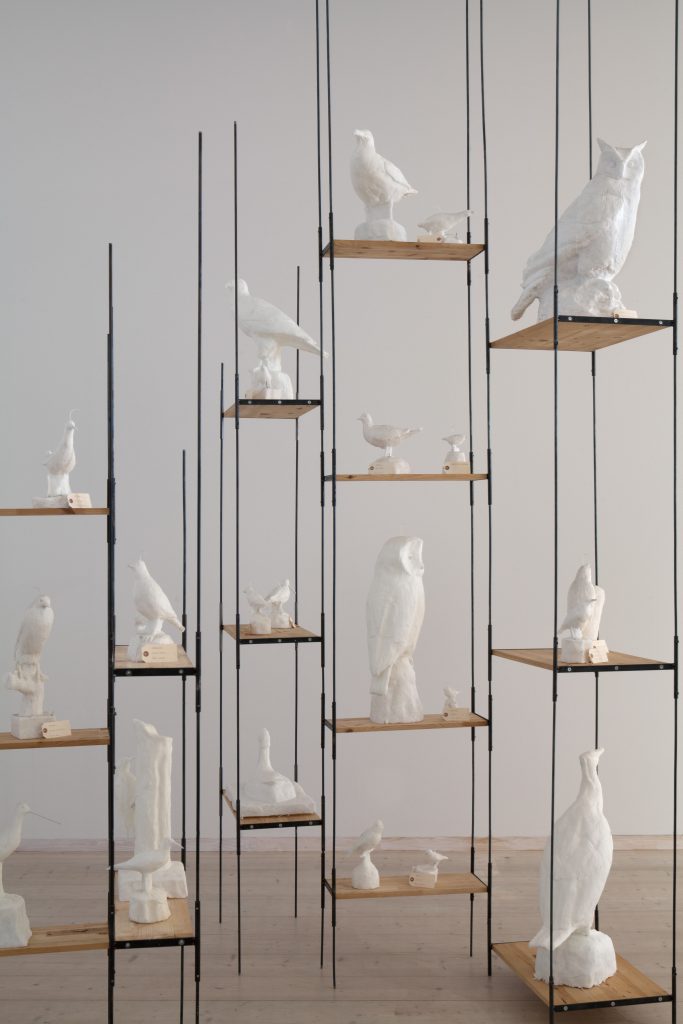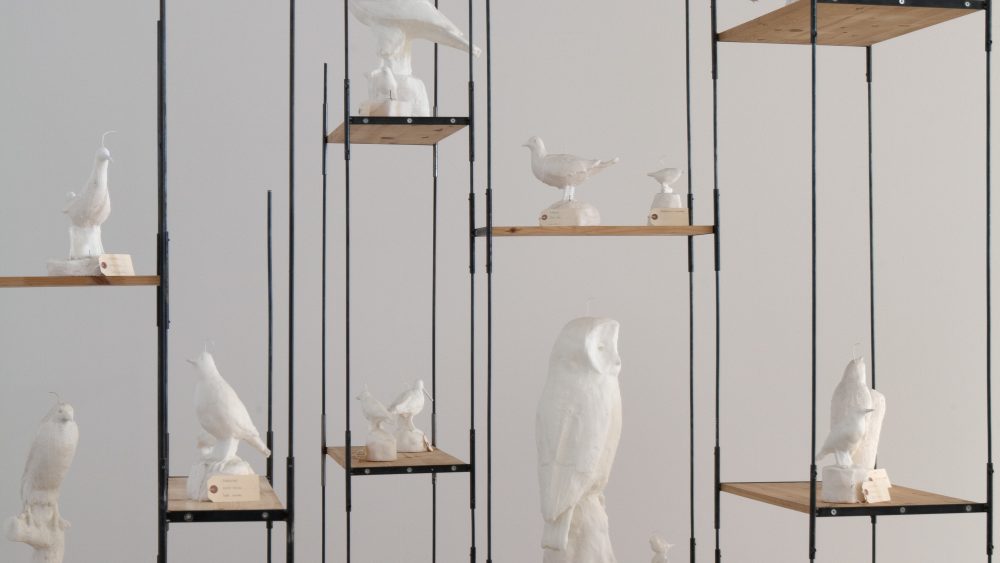[Featured image: Fredrik Strid, Alla fåglar i Sverige (detalj), 2018–2024. Foto: Emma Krantz/Skissernas Museum]
Having climbed the light and airy staircase to the second floor of Skissernas Museum, it takes a moment before I realise that the massive, black mass in front of me is not just a black wall, but a piece of art. It is called Eko (echo) and consists of lots of boxes on top of each other all painted black. But the containers are not secure it seems. From every crack and opening, what looks like thick, black paint or oil is dripping, forming puddles on the floor. A symbol of the echo of the, in part, dark past of museums, scientific collections, archives, and exhibitions. A reminder to students and staff of universities and research institutions that sometimes scientific achievements have been made thanks to what we would now consider unethical methods, and to take a moment to thank those who paid for it, perhaps?

The link to natural history collections gets clearer when entering the second room. The 257 birds – one for each species in Sweden – made from stearin make up an impressive yet fragile collection. Apart from the fact that they are not just models of birds but also candles that can burn down in a matter of hours, they are standing on simple shelves with thin wires that are attached only to the floor, looking like one wrong turn might cause them to collapse. And while the fact that the sculptures are the same size as real birds makes them come alive, their lack of colour makes me wonder which species are threatened to go extinct. Will they, too, represent echoes from the past?

Sculpturer Fredrik Strid’s exhibition “Making Nature” took six years to complete [1, 2]. It is a multifaceted collection that raises questions about, inter alia, how the way we portrait nature affects how we understand, care, and ultimately govern nature. It also opens for discussions about the role of science, museums, archives, and other institutions in society, about the history of environmental politics – while some bird species are threatened, some, like the sea eagle have become symbols for how dedicated species protection can curb the curve – and much more.
Exhibitions like this, and indeed art in general, can be used to strengthen teaching for sustainability in many ways. In addition to the unlimited number of discussions that can be held, art can in unique ways portrait and make things that do not yet exist real and imaginable – like climate changed futures [e.g. 3]. This can, for instance, be a great support when training students’ anticipatory ability [see e.g. 4, 5]. Art can also help us think outside the box, as needed to achieve transformative change [see e.g. 6, 7] and evoke feelings supporting sustainability commitments [see e.g. 8].
Have you used art in your teaching for sustainability? Do you have exhibitions that you would recommend? Are you a sustainability-artist in one way or another? Please get in touch – we would love to hear from you!
Fredrik Strid’s exhibition “Making Nature” can be seen at Skissernas Museum until 22 September included. Lund University staff enters free of charge.
Skissernas Museum works with object-based pedagogy as part of courses and welcomes teaching staff and students for guided tours. Read more about Skissernas Museum: https://skissernasmuseum.se/en/about/education-research/
[1]: Making Nature – Skissernas Museum
[2]: more impressions from the exhibition – Recension: Fredrik Strid har skulpterat alla Sveriges fåglar – DN.se
[3]: Enter Carbon Ruins — Climaginaries
[4]: Systematic review of literature on sustainability competencies – https://www.frontiersin.org/journals/education/articles/10.3389/feduc.2021.785163/full
[5]: Teaching for Sustainability: Introducing Sustainability Competencies | Sustainability Forum (lu.se)
[6]: Overview of definitions – transformative change | IPBES secretariat
[8]: Sustainability | Free Full-Text | A Didactic Model of Sustainability Commitment (mdpi.com)

